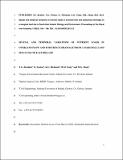Spatial and temporal variations of nutrient loads in overland flow and subsurface drainage on a marginal land site in South-East Ireland
Date
2013Author
Healy, Mark G.
Metadata
Show full item recordUsage
This item's downloads: 506 (view details)
Cited 16 times in Scopus (view citations)
Recommended Citation
Ibrahim, T. G., Fenton, O., Richards, K. G., Fely, R. M., & Healy, M. G. Spatial and temporal variations of nutrient loads in overland flow and subsurface drainage on a marginal land site in South-East Ireland. Biology & Environment: Proceedings of the Royal Irish Academy, 113(2), 1-18.
Published Version
Abstract
In Ireland, Food Harvest 2020 focuses on increasing productivity whilst enhancing environmental sustainability of agricultural land. On under-utilised or marginal land, drainage systems may be installed to expand agricultural enterprises. Mixed nutrient losses are inevitable from any drained system, but assessing processes leading to differences in nutrient speciation, fractionation and losses in grasslands between locations or flowpaths is important to achieve sustainability. This study investigates these processes in overland flow and subsurface drains over three rainfall events from four non-grazed plots recently converted from marginal land in the southeast of Ireland. A shallower water table and smaller plot size resulted in greater water and nutrient losses in overland flow per unit of land area. Nutrient losses were less in subsurface drains. Dissolved organic nitrogen dominated, but dissolved inorganic nitrogen was more abundant in the drains. Particulate phosphorus generally dominated in drains, except in plots with a shallow water table where dissolved unreactive phosphorus (DUP) was more abundant. In overland flow, a shallower water table resulted in a switch from dissolved reactive phosphorus (DRP) to DUP. Fertilization strongly increased phosphorus losses in overland flow, with DRP dominating. These results highlight the importance of an integrated assessment of the controls on flow and nutrient losses to design drainage systems in marginal lands.
Description
Journal article


